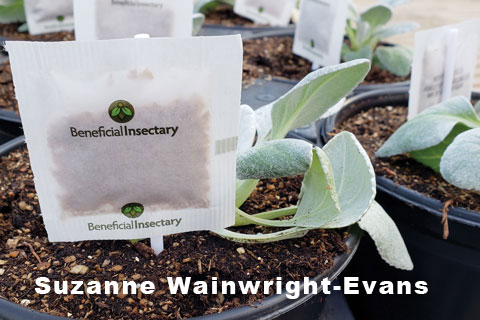2/1/2020
Bio Basics
Suzanne Wainwright-Evans

Years ago, when I got started working with commercial growers implementing biological control, the focus was on using biological control agents in the later stages of plant production. The idea was that when plants are small, you can get good spray coverage so spraying would make more sense. Then as the plants grew and the canopy got tighter, growers would move into using beneficials. The reasoning being the good guys can get down into the plants where sprays may not have been as effective, and there was also good bridging between plants allowing the beneficials to move through the crop.
Pictured: In propagation, cuttings are often close together, so it makes it easy for beneficials to move in the crop.
It sounded great until we realized that young plants were getting several applications of pesticides that could leave residues on the foliage, possibly negatively impacting the beneficials later. Also, there were concerns about cuttings coming in from off-shore with pests that already had pesticide resistance and may create a guessing game as to which MOA (mode of action) to apply.
This started us rethinking how to best manage pests. Basically, the industry did a flip-flop and now there’s a focus on using biological control agents in propagation. In doing this, we don’t have to worry if the pest is resistant to a particular pesticide (it’s nearly impossible to build resistance to being eaten). Beneficials are easy to apply on young plant crops, as the plants are often packed tightly on tables. Cost for treating in propagation is also very economical.
So how do you get started?
When I visit a grower for the first time, first we pick a specific crop. We then talk about the pest issues and whether there’s a viable biocontrol agent option. There aren’t commercially available biocontrol agents for all pests. We can treat a good range of the most common problems: many thrips species, many aphid species, fungus gnats, the two most common whiteflies, two-spotted spider mites, broad mites and a few other pests. If your target pest doesn’t have a BCA option, then we put together a spray program.
 Pictured: Damage from fungus gnat larvae on young plants. By applying beneficial nematodes, you can prevent this damage from happening.
Pictured: Damage from fungus gnat larvae on young plants. By applying beneficial nematodes, you can prevent this damage from happening.
Next we need to look at the economics of the program, bios vs. pesticides. Some growers are willing to pay more for a biological control program because of all the ancillary benefits (no pesticide residue, no worry with resistance issues, no REI or to be used for marketing purposes). Today, the price of biological control has become more in line with that of pesticides—and even in some cases, less expensive. It’s very hard to put a price tag on the benefits of using beneficials simply using the cost of BCAs vs. chemicals.
While doing all of this to control pest problems, we also have to be thinking about fungicide applications or other sprays that can impact the beneficials. People sometimes don’t realize that fungicides, as a side effect, can kill insects and mites. A good understanding of the interactions of all products applied to the crop will help inform your decision regarding which pesticides to use with BCAs. Check with your BCA supplier or pesticide supplier for compatibility information. Also, there are several mobile apps that have this information.
Once it’s been decided that beneficials are right for the crop, next the facility will need to find a supplier of beneficials. Many of the insectaries will sell directly to growers, as well as through distributors. What’s important is to find a person you’re comfortable working with and with whom you can build a relationship. You need someone who can help you answer the hard technical questions. Being proficient with beneficials is a highly sought-after skill these days because not many have been working for long in the field.
When you’re going to work with someone, ask them what qualifies them to provide you this level of technical support. When they recommend using a product, ask them why they selected that specific option. In short, ask a lot of questions of the person offering technical support. There should be solid reasoning behind every choice.
Check cuttings coming in
One of the stumbling blocks we sometimes hit is cuttings coming in that have pesticide residue on them that’s toxic or repelling to beneficials. You may think you’re doing all the right things, but the program just doesn’t work. This is why scouting is so important—to recognize this issue early and to change course.
You may need to change the beneficials to ones that may have higher pesticide tolerance. Moving into a spray program and selecting products that don’t have a long persistence could be a good option as well. Understanding the interactions may enable you to transition back into the beneficials in a few weeks.

Some options
One of the basic programs used in propagation for control of many (not all) pests is a combination of the predatory mite Neoseiulus cucumeris, foliar sprays of Beauveria bassiana (WP formulation) and drenching into the media the beneficial nematode Steinernema feltiae.
Pictured: Sachets are a slow-release delivery system from predatory mite. Not all species are available this way; they can be used in propagation and finished plant material.
N. cucumeris is a very handy little mite that’s been used for the management of western flower thrips, onion thrips and broad mites (and can help with suppressing two-spotted spider mite). There’s a lot of pesticide compatibility information available for this species from the insectaries and pesticide companies. All the insectaries have availability of this mite. They can be applied as a loose product (sprinkled over the plant) or in a slow-release sachet.
Beauveria bassiana is used to target the foliage feeding stages of thrips, as well as whiteflies. It’s also compatible with many (not all) biocontrol agents. The beneficial nematodes’ job is to target thrips pupa in the soil, as well as fungus gnat larvae that can be very damaging in the propagation stage.
All three (mite, fungus, nematode) of these products can be used in conjunction to give a good solid start to managing pests in propagation. You can still have other pests like aphids, but those can be managed with beneficials like lacewings or parasitic wasps. They also can be managed with compatible pesticide sprays that are well-timed.
The shift to using biological control agents in propagation is happening now. Many growers have made the change so they don’t have to worry about developing pesticide resistance or having a long-term pesticide residue on the young plants. Once the young plants move on, the finished grower has the option of either using beneficials or a pesticide spray program. Both ways of growing can benefit from young plants grown with biological control agents.
If you want to use beneficials to finish your crop out, you don’t have to worry about harmful pesticide residues on young plants. If you’d like to use a more traditional spray program, the plants you receive won’t have been heavily sprayed, reducing the risk of having received resistant insects or mites. GT
Suzanne Wainwright-Evans is the owner of Buglady Consulting, now in business 20 years. She specializes in biological control agents and troubleshooting pest issues in ornamentals, cannabis and other specialty crops.